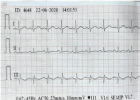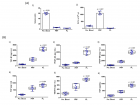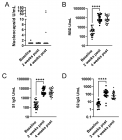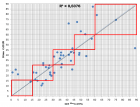Abstract
Editorial
Varicella zoster virus: The potentially useful virus
Al-Anazi KA* and Al-Jasser AM
Published: 05 July, 2019 | Volume 3 - Issue 1 | Pages: 011-015
Varicella zoster virus (VZV), a double-stranded DNA virus, is a highly contagious human neurotropic virus that belongs to the alpha group of herpes viruses [1-4]. Primary VZV infection (chickenpox) occurs in childhood then the virus becomes latent in the nerve ganglia [1,5-7]. Reactivation of the virus may occur decades later and cause herpes zoster (HZ) which is manifested by a typical painful skin eruption that has characteristic dermatomal distribution [1,5]. Reactivation of VZV is usually predisposed to: old age; comorbid medical conditions such as diabetes mellitus, chronic obstructive airway disease, and end-stage renal disease; and immunosuppression due to malignancy, autoimmune disorders, immunosuppressive therapies, trauma, cytotoxic chemotherapy, hematopoietic stem cell transplantation (HSCT), and solid organ transplantation (SOT) [1,5-7].
Read Full Article HTML DOI: 10.29328/journal.jhcr.1001009 Cite this Article Read Full Article PDF
References
- Kennedy PGE, Gershon AA. Clinical features of varicella-zoster virus infection. Viruses. 2018; 10: E609. PubMed: https://bit.ly/2XqPx7d
- Weber DJ. Prevention and control of varicella-zoster virus in hospitals.2019.
- Cohrs RJ, Gilden DH, Mahalingam R. Varicella zoster virus latency, neurological disease and experimental models: an update. Front Biosci. 2004; 9: 751-762. PubMed: https://bit.ly/32aVMuQ
- Al-Anazi KA, Kanfar S, Aldayel A, Abduljalil O, Sayyed AH. Reversal of pure red cell aplasia by varicella zoster virus infection. J Hematol Clin Res 2019; 3: 001-010.
- Albrecht MA, Levin MJ. Epidemiology, clinical manifestations and diagnosis of herpes zoster. 2019.
- Onozawa M, Hashino S, Takahata M, Fujisawa F, Kawamura T, et al. Relationship between preexisting anti-varicella-zoster virus (VZV) antibody and clinical VZV reactivation in hematopoietic stem cell transplantation recipients. J Clin Microbiol. 2006; 44: 4441-4443. PubMed: https://bit.ly/2XnEMOc
- Cvjetković D, Jovanović J, Hrnjaković-Cvjetković I, Brkić S, Bogdanović M. Reactivation of herpes zoster infection by varicella-zoster virus. Med Pregl. 1999; 52: 125-128. PubMed: https://bit.ly/2FTuC1X
- Yetgin S, Kuşkonmaz B, Aytaç S, Cetin M. The evaluation of acquired aplastic anemia in children and unexpected frequency of varicella-zoster virus association: a single-center study. Turk J Pediatr. 2008; 50: 342-348. PubMed: https://bit.ly/2FOIURq
- Pascutti MF, Erkelens MN, Nolte MA. Impact of viral infections on hematopoiesis: from beneficial to detrimental effects on bone marrow output. Front Immunol. 2016; 7: 364. PubMed: https://bit.ly/2XrrHTX
- Kakish K, Basak RB, Al Dhuhouri J, Chakraborty S. Four year old child with breakthrough varicella leading to pancytopenia. Bahrain Med Bull. 2009; 31, 2.
- Muthu V, Kumar PS, Varma S, Malhotra P. Varicella zoster virus-related pancytopenia. Int J Infect Dis. 2013; 17: e1264. PubMed: https://bit.ly/2xqOsNw
- Kuskonmaz B, Cetin M, Uckan D, Yetgin S. Varicella zoster-associated severe aplastic anemia in a child and its successful treatment with peripheral blood stem cell transplantation from HLA-5/6-identical donor. Med Sci Monit. 2007; 13: CS128-131. PubMed: https://bit.ly/2XnY1qZ
- Ragozzino MW, Melton LJ 3rd, Kurland LT, Chu CP, Perry HO. Risk of cancer after herpes zoster: a population-based study. N Engl J Med. 1982; 307: 393-397. PubMed: https://bit.ly/2RWKYM3
- Ho JD, Xirasagar S, Lin HC. Increased risk of a cancer diagnosis after herpes zoster ophthalmicus: a nationwide population-based study. Ophthalmology. 2011; 118: 1076-1081. PubMed: https://bit.ly/2JoKbj4
- Schmidt SA, Mor A, Schønheyder HC, Sørensen HT, Dekkers OM, et al. Herpes zoster as a marker of occult cancer: A systematic review and meta-analysis. J Infect. 2017; 74: 215-235. PubMed: https://bit.ly/2XE7HC3
- Liu YC, Yang YH, Hsiao HH, Yang WC, Liu TC, et al. Herpes zoster is associated with an increased risk of subsequent lymphoid malignancies - a nationwide population-based matched-control study in Taiwan. BMC Cancer. 2012; 12: 503. PubMed: https://bit.ly/309KcOz
- Mays RM, Murthy RK, Gordon RA, Lapolla WJ, Galfione SK, et al. Diffuse Large B-Cell Lymphoma at the site of a herpes zoster scar. World J Oncol. 2012; 3: 199-203. PubMed: https://bit.ly/2Jlt7up
- Al-Anazi KA, Al-Jasser AM, Evans DA. Effect of varicella zoster virus infection on bone marrow function. Eur J Haematol. 2005; 75: 234-240. PubMed: https://bit.ly/2YwMzL7
- Kamber C, Zimmerli S, Suter-Riniker F, Mueller BU, Taleghani BM, et al. Varicella zoster virus reactivation after autologous SCT is a frequent event and associated with favorable outcome in myeloma patients. Bone Marrow Transplant. 2015; 50: 573-578. PubMed: https://bit.ly/2KXAsU3
- Kawano N, Gondo H, Kamimura T, Aoki K, Iino T, et al. Chronic graft-versus-host disease following varicella-zoster virus infection in allogeneic stem cell transplant recipients. Int J Hematol. 2003; 78: 370-373. PubMed: https://bit.ly/2RQFvXc
- Raymond AK, Singletary HL, Nelson KC, Sidhu-Malik NK. Dermatomal sclerodermoid graft-vs-host disease following varicella-zoster virus infection. Arch Dermatol. 2011; 147: 1121-1122. PubMed: https://bit.ly/2XJokfn
- Baselga E, Drolet BA, Segura AD, Leonardi CL, Esterly NB. Dermatomal lichenoid chronic graft-vs-host disease following varicella-zoster infection despite absence of viral genome. J Cutan Pathol. 1996; 23: 576-581. PubMed: https://bit.ly/2NGLdfA
- Weisdorf D, Zhang MJ, Arora M, Horowitz MM, Rizzo JD, et al. Graft-versus-host disease induced graft-versus-leukemia effect: greater impact on relapse and disease-free survival after reduced intensity conditioning. Biol Blood Marrow Transplant. 2012; 18: 1727-1733. PubMed: https://bit.ly/30a1MSG
- Yeshurun M, Weisdorf D, Rowe JM, Tallman MS, Zhang MJ, et al. The impact of the graft-versus-leukemia effect on survival in acute lymphoblastic leukemia. Blood Adv. 2019; 3: 670-680. PubMed: https://bit.ly/2XE8vqz
- Negrin RS. Graft-versus-host disease versus graft-versus-leukemia. Hematology Am Soc Hematol Educ Program. 2015; 2015: 225-30.
- Belcaid Z, Lamfers ML, van Beusechem VW, Hoeben RC. Changing faces in virology: the Dutch shift from oncogenic to oncolytic viruses. Hum Gene Ther. 2014; 25: 875-884. PubMed: https://bit.ly/2XrnYWy
- Rudd PA, Herrero LJ. Viruses: Friends and foes. In: Cartilage repair and regeneration. 2017.
- Fukuhara H, Ino Y, Todo T. Oncolytic virus therapy: A new era of cancer treatment at dawn. Cancer Sci. 2016; 107: 1373-1379. PubMed: https://bit.ly/2xqQbT0
- Ajina A, Maher J. Prospects for combined use of oncolytic viruses and CAR T-cells. J Immunother Cancer. 2017; 5: 90.
- Howells A, Marelli G Lemoine NR, Wang Y. Oncolytic viruses-interaction of virus and tumor cells in the battle to eliminate cancer. Front Oncol. 2017; 7: 195. PubMed: https://bit.ly/2LAu6th
- Guo C, Manjili MH, Subjeck JR, Sarkar D, Fisher PB, et al. Therapeutic cancer vaccines: past, present, and future. Adv Cancer Res. 2013; 119: 421-475. PubMed: https://bit.ly/2RTgtqa
- Chaurasiya S, Chen NG, Warner SG. Oncolytic virotherapy versus cancer stem cells: a review of approaches and mechanisms. Cancers. 2018; 10: E124. PubMed: https://bit.ly/2KYBwY1
- Wennier ST, Liu J, McFadden G. Bugs and drugs: oncolytic virotherapy in combination with chemotherapy. Curr Pharm Biotechnol. 2012; 13: 1817-1833. PubMed: https://bit.ly/30cuW3G
- Amirian ES, Scheurer ME, Zhou R, Wrensch MR, Armstrong GN, et al. History of chickenpox in glioma risk: a report from the glioma international case-control study (GICC). Cancer Med. 2016; 5: 1352-1358. PubMed: https://bit.ly/2Nx6Cbg
- Pundole X, Amirian ES, Scheurer ME. Role of varicella zoster virus in glioma risk: Current knowledge and future directions. OA Epidemiology. 2014; 2: 6.
- Canniff J, Donson AM, Foreman NK, Weinberg A. Cytotoxicity of glioblastoma cells mediated ex vivo by varicella-zoster virus-specific T cells. J Neurovirol. 2011; 17: 448-454. PubMed: https://bit.ly/2YCBWqg
- Leske H, Haase R, Restle F, Schichor C, Albrecht V, et al. Varicella zoster virus infection of malignant glioma cell cultures: a new candidate for oncolytic virotherapy? Anticancer Res. 2012; 32: 1137-1144.
- Haberthur K, Messaoudi I. Animal models of varicella zoster virus infection. Pathogens. 2013; 2: 364-382. PubMed: https://bit.ly/2JmPjEp
- Goodwin TJ, McCarthy M, Osterrieder N, Cohrs RJ, Kaufer BB. Three-dimensional normal human neural progenitor tissue-like assemblies: a model of persistent varicella-zoster virus infection. PLoS Pathog. 2013; 9: e1003512. PubMed: https://bit.ly/2Xsp7SM
- Shahzad A, Gilden D, Cohrs RJ. Translational medicine and varicella zoster virus: Need for disease modeling. New Horiz Transl Med. 2015; 2: 89-91. PubMed: https://bit.ly/2xsMZ9h
- Harada K, Heaton H, Chen J, Vazquez M, Meyer J. Zoster vaccine-associated primary varicella infection in an immunocompetent host. BMJ Case Rep. 2017; 2017: bcr-2017-221166. PubMed: https://bit.ly/2XJoDXz
- Leung J, Broder KR, Marin M. Severe varicella in persons vaccinated with varicella vaccine (breakthrough varicella): A systematic literature review. Expert Rev Vaccines. 2017; 16: 391-400. PubMed: https://bit.ly/2LCIscz
- Khandelwal P, Marsh RA, Scott Scmid D, Radford KW, Bleesing J, et al. Case series of vaccine associated varicella zoster virus infection in immune compromised patients. Biol Blood Marrow Transplant. 2013; 19: S250.
- Bhalla P, Forrest GN, Gershon M, Zhou Y, Chen J, et al. Disseminated, persistent, and fatal infection due to the vaccine strain of varicella-zoster virus in an adult following stem cell transplantation. Clin Infect Dis. 2015; 60: 1068-1074. PubMed: https://bit.ly/2NxuXNW
- Willis ED, Woodward M, Brown E, Popmihajlov Z, Saddier P, et al. Herpes zoster vaccine live: a 10 year review of post-marketing safety experience. Vaccine. 2017; 35: 7231-7239. PubMed: https://bit.ly/2FTwTu1
- Wang L, Verschuuren EAM, van Leer-Buter CC, Bakker SJL, de Joode AAE, et al. Herpes zoster and immunogenicity and safety of zoster vaccines in transplant patients: a narrative review of the literature. Front Immunol. 2018; 9: 1632. PubMed: https://bit.ly/2Nz1a7F
- Aoki T, Koh K, Kawano Y, Mori M, Arakawa Y, et al. Safety of live attenuated high-titer varicella-zoster virus vaccine in pediatric allogeneic hematopoietic stem cell transplantation recipients. Biol Blood Marrow Transplant. 2016; 22: 771-775. PubMed: https://bit.ly/30cIWuk
- Winston DJ, Mullane KM, Cornely OA, Boeckh MJ, Brown JW, et al.; V212 Protocol 001 Trial Team. Inactivated varicella zoster vaccine in autologous haemopoietic stem-cell transplant recipients: An international, multicentre, randomised, double-blind, placebo-controlled trial. Lancet 2018; 391: 2116-2127. PubMed: https://bit.ly/2NwjDBI
- Sasadeusz J, Prince HM, Schwarer A, Szer J, Stork A, et al. Immunogenicity and safety of a two-dose live attenuated varicella vaccine given to adults following autologous hematopoietic stem cell transplantation. Transpl Infect Dis. 2014; 16: 1024-1031. PubMed: https://bit.ly/2NA4sre
- Parrino J, McNeil SA, Lawrence SJ, Kimby E, Pagnoni MF, et al. Safety and immunogenicity of inactivated varicella-zoster virus vaccine in adults with hematologic malignancies receiving treatment with anti-CD20 monoclonal antibodies. Vaccine. 2017; 35: 1764-1769. PubMed: https://bit.ly/2Jc7XA8
- Leung TF, Li CK, Hung EC, Chan PK, Mo CW, et al. Immunogenicity of a two-dose regime of varicella vaccine in children with cancers. Eur J Haematol. 2004; 72: 353-357. PubMed: https://bit.ly/2xsqgu5
- Ohfuji S, Ito K, Inoue M, Ishibashi M, Kumashiro H, et al. Safety of live attenuated varicella-zoster vaccine in patients with underlying illnesses compared with healthy adults: A prospective cohort study. BMC Infect Dis. 2019; 19: 95. PubMed: https://bit.ly/2S2jtkt
- Eberhardson M, Hall S, Papp KA, Sterling TM, Stek JE, et al. Safety and immunogenicity of inactivated varicella-zoster virus vaccine in adults with autoimmune disease: A phase 2, randomized, double-blind, placebo-controlled clinical trial. Clin Infect Dis. 2017; 65: 1174-1182. PubMed: https://bit.ly/2Xr0DZT
- Russell AF, Parrino J, Fisher CL Jr, Spieler W, Stek JE, et al. Safety, tolerability, and immunogenicity of zoster vaccine in subjects on chronic/ maintenance corticosteroids. Vaccine. 2015; 33: 3129-3134. PubMed: https://bit.ly/2FQXMyM
- Mills R, Tyring SK, Levin MJ, Parrino J, Li X, et al. Safety, tolerability, and immunogenicity of zoster vaccine in subjects with a history of herpes zoster. Vaccine. 2010; 28: 4204-4209. PubMed: https://tinyurl.com/y6sa9nhs
- Agarwala S, Tamplin OJ. Neural crossroads in the hematopoietic stem cell niche. Trends Cell Biol. 2018; 28: 987-998. PubMed: https://tinyurl.com/yxjeyetc
- Boiko JR, Borghesi L. Hematopoiesis sculpted by pathogens: Toll-like receptors and inflammatory mediators directly activate stem cells. Cytokine. 2012; 57:1-8. PubMed: https://tinyurl.com/y4gk5xcw
- Zhao JL, Baltimore D. Regulation of stress-induced hematopoiesis. Curr Opin Hematol. 2015; 22: 286-292.
- Pleyer L, Valent P, Greil R. Mesenchymal stem and progenitor cells in normal and dysplastic hematopoiesis-masters of survival and clonality? Int J Mol Sci. 2016; 17: E1009. PubMed: https://tinyurl.com/y56v96kc
- Avanzi S, Leoni V, Rotola A, Alviano F, Solimando L, et al. Susceptibility of human placenta derived mesenchymal stromal/stem cells to human herpesviruses infection. PLoS One. 2013; 8: e71412. PubMed: https://tinyurl.com/y6s43fcl
- Auletta JJ, Deans RJ, Bartholomew AM. Emerging roles for multipotent, bone marrow-derived stromal cells in host defense. Blood. 2012; 119:1801-1809. PubMed: https://tinyurl.com/y3473tet
- Nowakowski A, Drela K, Rozycka J, Janowski M, Lukomska B. Engineered mesenchymal stem cells as an anti-cancer Trojan horse. Stem Cells Dev. 2016; 25: 1513-1531. PubMed: https://tinyurl.com/y5x8ths2
- Abendroth A, Morrow G, Cunningham AL, Slobedman B. Varicella-zoster virus infection of human dendritic cells and transmission to T cells: Implications for virus dissemination in the host. J Virol. 2001; 75: 6183-6192. PubMed: https://tinyurl.com/y3uvhnd4
- Morrow G, Slobedman B, Cunningham AL, Abendroth A. Varicella-zoster virus productively infects mature dendritic cells and alters their immune function. J. Virol. 2003; 77: 4950-4959. PubMed: https://tinyurl.com/y53kdqqs
- Handgretinger R, Lang P, André MC. Exploitation of natural killer cells for the treatment of acute leukemia. Blood. 2016; 127: 3341-3349. PubMed: https://tinyurl.com/y36xbrcu
- Campbell TM, McSharry BP, Steain M, Ashhurst TM, Slobedman B, et al. Varicella zoster virus productively infects human natural killer cells and manipulates phenotype. PLoS Pathog. 2018; 14: e1006999. PubMed: https://tinyurl.com/y6eusgrw
- Weinberg A, Levin MJ. VZV T cell-mediated immunity. Curr Top Microbiol. Immunol. 2010; 342: 341-57.
- Jones D, Como CN, Jing L, Blackmon A, Neff CP, et al. Varicella zoster virus productively infects human peripheral blood mononuclear cells to modulate expression of immunoinhibitory proteins and blocking PD-L1 enhances virus-specific CD8+ T cell effector function. PLoS Pathog. 2019; 15: e1007650. PubMed: https://tinyurl.com/y3bww5x6
- Sommer MH, Zagha E, Serrano OK, Ku CC, Zerboni L, et al. Mutational analysis of the repeated open reading frames, ORFs 63 and 70 and ORFs 64 and 69, of varicella-zoster virus. J Virol. 2001; 75: 8224-8239. PubMed: https://tinyurl.com/y29a7r7r
- Lenac Roviš T, Bailer SM, Pothineni VR, Ouwendijk WJ, Šimić H, et al. Comprehensive analysis of varicella-zoster virus proteins using a new monoclonal antibody collection. J Virol. 2013; 87: 6943-6954. PubMed: https://tinyurl.com/y3w5paex
- Lallemand-Breitenbach V, de Thé H. PML nuclear bodies. Curr Opin Cell Biol. 2018; 52: 154-161. PubMed: https://tinyurl.com/y4plm9lj
- Kyratsous CA, Silverstein SJ. BAG3, a host cochaperone, facilitates varicella-zoster virus replication. J Virol. 2007; 81: 7491-7503. PubMed: https://tinyurl.com/y5r9yg7o
- Mattoscio D, Segré CV, Chiocca S. Viral manipulation of cellular protein conjugation pathways: The SUMO lesson. World J Virol. 2013; 2: 79-90. PubMed: https://tinyurl.com/y3ntxxq8
- Bello-Morales R, López-Guerrero JA. Extracellular vesicles in herpes viral spread and immune evasion. Front Microbiol. 2018; 9: 2572. PubMed: https://tinyurl.com/y435rqj5
- Anderson MR, Kashanchi F, Jacobson S. Exosomes in viral disease. Neurotherapeutics. 2016; 13: 535-546.
- Li X, Huang Y, Zhang Y, He N. Evaluation of microRNA expression in patients with herpes zoster. Viruses. 2016; 8: E326. PubMed: https://tinyurl.com/y4fxlzdz
- Zajkowska A, Garkowski A, Świerzbińska R, Kułakowska A, Król ME, et al. Evaluation of chosen cytokine levels among patients with herpes zoster as ability to provide immune response. PLoS One. 2016; 11: e0150301. PubMed: https://tinyurl.com/y4a6gg23
- Zak-Prelich M, McKenzie RC, Sysa-Jedrzejowska A, Norval M. Local immune responses and systemic cytokine responses in zoster: relationship to the development of postherpetic neuralgia. Clin Exp Immunol. 2003; 131: 318-323. PubMed: https://tinyurl.com/y3spcyb9
- Jones D, Neff CP, Palmer BE, Stenmark K, Nagel MA. Varicella zoster virus-infected cerebrovascular cells produce a proinflammatory environment. Neurol Neuroimmunol Neuroinflamm. 2017; 4: e382. PubMed: https://tinyurl.com/y5r8jtq7
- Bubak AN, Como CN, Blackmon AM, Jones D, Nagel MA. Varicella zoster virus differentially alters morphology and suppresses proinflammatory cytokines in primary human spinal cord and hippocampal astrocytes. J Neuroinflammation. 2018; 15: 318. PubMed: https://tinyurl.com/y3uc6edb
- de Visser L, H de Boer J, T Rijkers G, Wiertz K, van den Ham HJ, et al. Cytokines and chemokines involved in acute retinal necrosis. Invest Ophthalmol Vis Sci. 2017; 58: 2139-2151. PubMed: https://tinyurl.com/y2ome53j
- Verweij MC, Wellish M, Whitmer T, Malouli D, Lapel M, et al. Varicella viruses inhibit interferon-stimulated JAK-STAT signaling through multiple mechanisms. PLoS Pathog. 2015; 11: e1004901. PubMed: https://tinyurl.com/y6nn3dsp
- Rahaus M, Desloges N, Wolff MH. Varicella-zoster virus influences the activities of components and targets of the ERK signalling pathway. J Gen Virol. 2006; 87: 749-758. PubMed: https://tinyurl.com/y2axb3fg
- Kurapati S, Sadaoka T, Rajbhandari L, Jagdish B, Shukla P, et al. Role of the JNK pathway in varicella-zoster virus lytic infection and Reactivation. J Virol. 2017; 91: e00640-17. PubMed: https://tinyurl.com/y55zksve
- Rahaus M, Desloges N, Wolff MH. Varicella-zoster virus requires a functional PI3K/Akt/GSK-3alpha/beta signaling cascade for efficient replication. Cell Signal. 2007; 19: 312-320. PubMed: https://tinyurl.com/y3magfsr
- Grigoryan S, Yee MB, Glick Y, Gerber D, Kepten E, et al. Direct transfer of viral and cellular proteins from varicella-zoster virus-infected non-neuronal cells to human axons. PLoS One. 2015; 10: e0126081. PubMed: https://tinyurl.com/y68bxr5w
- Grose C, Buckingham EM, Carpenter JE, Kunkel JP. Varicella-zoster virus infectious cycle: ER stress, autophagic flux, and amphisome-mediated trafficking. Pathogens. 2016; 5: E67. PubMed: https://tinyurl.com/y63xvhww
Similar Articles
-
Primary Cutaneous Lymphomas and Interferon TreatmentAjda ERSOY GUNES,Melda COMERT OZKAN*,Fahri SAHIN,Guray SAYDAM. Primary Cutaneous Lymphomas and Interferon Treatment. . 2017 doi: 10.29328/journal.jhcr.1001001; 1: 001-010
-
Neutrophil to Lymphocyte Ratio (NLR) in Peripheral Blood: A Novel and Simple Prognostic Predictor of Non-small Cell Lung Cancer (NSCLC)Xiaoli Zhang,Ziyuan Zou,Liyu Fan,Xinjie Xu,Yu Siyuan,Peng Luo*. Neutrophil to Lymphocyte Ratio (NLR) in Peripheral Blood: A Novel and Simple Prognostic Predictor of Non-small Cell Lung Cancer (NSCLC). . 2017 doi: 10.29328/journal.jhcr.1001002; 1: 011-013
-
Cytomegalovirus pneumonia and Cryptogenic organizing pneumonia following pediatric stem cell transplantation for leukemiaZühre Kaya*,Tuba Şişmanlar,Ayşe Tana Aslan,Öznur Konuş Boyunağa,Işıl Fidan Balcı,İdil Yenicesu,Ülker Koçak. Cytomegalovirus pneumonia and Cryptogenic organizing pneumonia following pediatric stem cell transplantation for leukemia. . 2017 doi: 10.29328/journal.jhcr.1001003; 1: 014-018
-
Preservation of Haemostasis with Anti-thrombotic Serotonin AntagonismMark IM Noble*,Angela J Drake-Holland. Preservation of Haemostasis with Anti-thrombotic Serotonin Antagonism. . 2017 doi: 10.29328/journal.jhcr.1001004; 1: 019-025
-
Status of protection against Hepatitis B infection among healthcare workers (HCW) in a tertiary healthcare center in India: results can’t be ignored!Pandey Prashant,Agarwal Nitin*,Das Suryasanta,Dharmendra Kumar. Status of protection against Hepatitis B infection among healthcare workers (HCW) in a tertiary healthcare center in India: results can’t be ignored!. . 2018 doi: 10.29328/journal.jhcr.1001005; 2: 001-005
-
Evaluation of the effects of Leech Salivary Extract (LSE) on Haematological parameters in RatsHausatu Babayi*,Ojo Olufunmilola Praise,Labake Fadipe Ajoke,Israel Kayode Olayemi,Elisha Baba,Oladosun Oluwale Peter. Evaluation of the effects of Leech Salivary Extract (LSE) on Haematological parameters in Rats. . 2018 doi: 10.29328/journal.jhcr.1001006; 2: 006-014
-
Successful management of disseminated Fusarium infection in a patient with acute myeloid leukemiaAlShammasi S,AlNujaidi D,Bakhit K,Algarni A,AlAnazi KA*. Successful management of disseminated Fusarium infection in a patient with acute myeloid leukemia. . 2018 doi: 10.29328/journal.jhcr.1001007; 2: 015-020
-
Reversal of pure red cell aplasia by varicella zoster virus infectionAl-Anazi KA*,Kanfar S,Aldayel A,Abduljalil O,Sayyed AH. Reversal of pure red cell aplasia by varicella zoster virus infection. . 2019 doi: 10.29328/journal.jhcr.1001008; 3: 001-010
-
Varicella zoster virus: The potentially useful virusAl-Anazi KA*,Al-Jasser AM. Varicella zoster virus: The potentially useful virus. . 2019 doi: 10.29328/journal.jhcr.1001009; 3: 011-015
-
The beneficial effects of varicella zoster virusKhalid Ahmed Al-Anazi*,Al-Anazi WK,Al-Jasser AM. The beneficial effects of varicella zoster virus. . 2019 doi: 10.29328/journal.jhcr.1001010; 3: 016-049
Recently Viewed
-
Treatment Outcome in Patients with Myofascial Orofacial Pain: A Randomized Clinical TrialAnders Wänman*, Susanna Marklund, Negin Yekkalam. Treatment Outcome in Patients with Myofascial Orofacial Pain: A Randomized Clinical Trial. J Oral Health Craniofac Sci. 2024: doi: 10.29328/journal.johcs.1001046; 9: 001-008
-
Hygiene and Care Protocols for Implant-supported Dental Prostheses in Patients with DiabetesHakob Khachatryan, Emma Boshnaghyan, Sevak Papoyan, Gagik Hakobyan*. Hygiene and Care Protocols for Implant-supported Dental Prostheses in Patients with Diabetes. J Oral Health Craniofac Sci. 2024: doi: 10.29328/journal.johcs.1001047; 9: 009-014
-
Advancing Oral Health and Craniofacial Science through Microchip ImplantsShekufeh Shafeie*. Advancing Oral Health and Craniofacial Science through Microchip Implants. J Oral Health Craniofac Sci. 2024: doi: 10.29328/journal.johcs.1001048; 9: 015-018
-
Texture Analysis of Hard Tissue Changes after Sinus Lift Surgery with Allograft and XenograftMohammad Azimzadeh, Farzad Esmaeili, Narges Bayat, Kasra Rahimipour, Amir Ebrahimpour Tolouei*. Texture Analysis of Hard Tissue Changes after Sinus Lift Surgery with Allograft and Xenograft. J Oral Health Craniofac Sci. 2024: doi: 10.29328/journal.johcs.1001049; 9: 019-022
-
Awareness and Knowledge of Specialists/Trainers and General Dental Practitioners about Medical-Related Osteonecrosis of the JawsAbdulhamit Taha Koca,Mustafa Bayhan,Yunus Ayberk Demir,Ayse Zeynep Zengin*. Awareness and Knowledge of Specialists/Trainers and General Dental Practitioners about Medical-Related Osteonecrosis of the Jaws. J Oral Health Craniofac Sci. 2024: doi: 10.29328/journal.johcs.1001050; 9: 023-031
Most Viewed
-
Evaluation of Biostimulants Based on Recovered Protein Hydrolysates from Animal By-products as Plant Growth EnhancersH Pérez-Aguilar*, M Lacruz-Asaro, F Arán-Ais. Evaluation of Biostimulants Based on Recovered Protein Hydrolysates from Animal By-products as Plant Growth Enhancers. J Plant Sci Phytopathol. 2023 doi: 10.29328/journal.jpsp.1001104; 7: 042-047
-
Sinonasal Myxoma Extending into the Orbit in a 4-Year Old: A Case PresentationJulian A Purrinos*, Ramzi Younis. Sinonasal Myxoma Extending into the Orbit in a 4-Year Old: A Case Presentation. Arch Case Rep. 2024 doi: 10.29328/journal.acr.1001099; 8: 075-077
-
Feasibility study of magnetic sensing for detecting single-neuron action potentialsDenis Tonini,Kai Wu,Renata Saha,Jian-Ping Wang*. Feasibility study of magnetic sensing for detecting single-neuron action potentials. Ann Biomed Sci Eng. 2022 doi: 10.29328/journal.abse.1001018; 6: 019-029
-
Pediatric Dysgerminoma: Unveiling a Rare Ovarian TumorFaten Limaiem*, Khalil Saffar, Ahmed Halouani. Pediatric Dysgerminoma: Unveiling a Rare Ovarian Tumor. Arch Case Rep. 2024 doi: 10.29328/journal.acr.1001087; 8: 010-013
-
Physical activity can change the physiological and psychological circumstances during COVID-19 pandemic: A narrative reviewKhashayar Maroufi*. Physical activity can change the physiological and psychological circumstances during COVID-19 pandemic: A narrative review. J Sports Med Ther. 2021 doi: 10.29328/journal.jsmt.1001051; 6: 001-007

HSPI: We're glad you're here. Please click "create a new Query" if you are a new visitor to our website and need further information from us.
If you are already a member of our network and need to keep track of any developments regarding a question you have already submitted, click "take me to my Query."



















































































































































